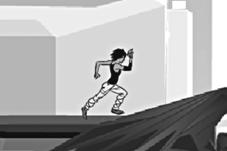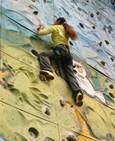题目内容
Parkour is a sport with the aim of moving from one point to another as smoothly, efficiently and quickly as possible using chiefly the abilities of the human body. It’s more similar to martial arts (武术) than to a sport. Parkour focuses on how any obstacle is dealt with, whether the obstacle is either physical or mental.
Inspiration for parkour came from the “Natural Method of Physical Culture” developed by Georges Hebert in the early twentieth century. French soldiers in Vietnam were inspired by Heber’s work and created what is now known as parcours du combatant (障碍训练课程). David Belle, who was introduced to this method by his father Raymond Belle, a Vietnamese soldier who had practiced it, had taken part in activities such as martial arts and gymnastics, and sought to apply his athletic skill in a manner that would have practical use in life.
After moving to Lisses, David Belle continued his journey with others. “From then on we developed,” says Sebastien Foucan, who helped to spread parkour, “and really the whole town was there for us; there for parkour.”
Over the years as devoted practitioners (实践者) improved their skills, their moves continued to grow in scale, so that building-to-building jumps and drops of over a storey(楼层) became common in media description, causing much misunderstanding on the nature of parkour.”
Although many practitioners say parkour isn’t an extreme sport, it does carry risk with it. The practice of running, jumping, and leaping from a variety of urban structures (roof tops, staircases, raised surfaces, walls, etc.) and landing on concrete, of course, carries the potential for injury. Some of the most common injuries include sprained (扭伤的) ankles and injuries to the knees.
According to one practitioner, “One of the biggest differences between parkour and other so-called ‘extreme’ sports is that it is not concerned only with physical skills, but also with one’s mental and spiritual pleasure.”
1. The second paragraph is mainly about _______.
A. Belle’s devotion to parkour B. the origin of parkour
C. the use of parkour during wartime D. the practical use of parkour in life
2. What do we know about David Belle?
A. He used to be a French soldier in Vietnam.
B. His attitude toward Hebert’s work was negative.
C. He and Foucan held different views on parkour.
D. He attempted to make full use of his athletic skill in life.
3. What do we infer from the passage?
A. The practitioners think parkour is worth the risk.
B. Parkour needs specially designed training places.
C. The practitioners are often blamed by the media.
D. Parkour was developed in the early twentieth century.
4. Parkour requires _______.
A. only the abilities of human body
B. move from one point to another
C. the ability to deal with mental problems
D. the ability to remove obstacles physically and mentally
5. According to the passage, which of the following is parkour?
A.  B.
B. 
C.  D.
D. 
【小题1】B
【小题2】D
【小题3】A
【小题4】D
【小题5】A

 名校联盟快乐课堂系列答案
名校联盟快乐课堂系列答案 黄冈创优卷系列答案
黄冈创优卷系列答案Parkour (跑酷) is a new sport that is developing quickly in the world. The aim of parkour is to jump, climb or run over any all stair, or fence on your path easily. Usually, it is done in a city environment. Practicers take very wall or roof as their training place. If you have seen the beginning of the James Bond movie Casino Royale, then you have seen an excellent example of parkour.
David Belle, a young Frenchman, developed parkour in the 1990s. His father's experiences as a fireman as well as an acrobat(杂技演员)influenced him a lot. His childhood friend, Sebastien Foucan, is the actor in the movie Casino Royale with his parkour performance. Foucan is thought to have developed free-running, which is a more artistic and skillful type of parkour. David belle traveled to India and said one way he trained was by watching a physical one. The aim is to become so skillful, and it is almost unnecessary for you to think about the different actions in running through a path full of barriers(障碍物).
Parkour is not exactly a sport. It is not developed fro competition. It is more about learning to control mind and body in difficult situations. There are many basic movements in parkour. One example is where practicers swing through the narrow space between two bars while keeping their body level with the ground. This is called the underbar. Other movements are the tic-tac and the kong vault jump. Skillful practicers seem to get out of control of gravity.
The popularity has spread largely because of parkour videos and organizations on the Internet. And if you search on the Web, you will find parkour groups performing their skills near you.
【小题1】The author wrote this text to _______
| A.introduce a new sport parkour | B.show how parkour is popular in the world |
| C.Tell the history of parkour | D.explain the basic movements in parkour |
| A.David Belle. | B.James Bond. | C.Sebastien Foucan. | D.David Belle's father. |
| A.the newspaper | B.the Internet | C.the radio | D.TV |
| A.Children should not be allowed to do parkour. |
| B.Casino Royale is a movie introducing parkour |
| C.Most of the lovers of parkour are Internet users. |
| D.Parkour is a mental exercise as well as a physical one |
 “Our aim is to take our art to the world and make people understand what it is to move,” said David Belle, the founder of parkour(跑酷).
“Our aim is to take our art to the world and make people understand what it is to move,” said David Belle, the founder of parkour(跑酷). B.
B. 
 D.
D. 

 B.
B.

 D.
D. 